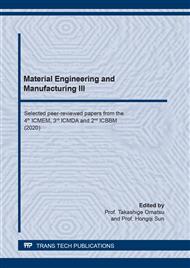[1]
American Diabetes Association, Diagnosis and classification of diabetes mellitus,, (2010).
Google Scholar
[2]
International Diabetes Federation, Diabetes,, (2015).
Google Scholar
[3]
Kementerian Kesehatan RI, Riset Kesehatan Dasar., Badan Penelitian dan Pengembangan Kesehatan Kementrian Kesehatan RI, Jakarta, (2013).
DOI: 10.14203/press.298
Google Scholar
[4]
L. D. Apriliani IF, Eti KR, Alfiko AM, Inhibition Test Of α-Glucosidase Based On Ginger, Lidah Buaya, and Secang., p.1–5, (2018).
Google Scholar
[5]
Yanto AR, Mahmudati N, Seduhan Jahe (Zingiber officinale rosce. ) dalam menurunkan kadar glukosa darah tikus model diabetes tipe 2 (NIDDM) sebagai sumber belajar biologi,, J. Pendidik. Biol. Indones., vol. 2, no. November, p.258–264, (2016).
DOI: 10.22219/jpbi.v2i3.3873
Google Scholar
[6]
S. Alinejad-mofrad, M. Foadoddini, S. A. Saadatjoo, and M. Shayesteh, Improvement of glucose and lipid profile status with Aloe vera in pre-diabetic subjects : a randomized controlled-trial,, p.1–7, (2015).
DOI: 10.1186/s40200-015-0137-2
Google Scholar
[7]
A. Yuniastuti and A. Marianti, Efek pemberian jus llidah buaya terhadap kadar glukosa darah tikus putih,, Unnes J. Life Sci., vol. 1, no. 1, p.36–40, (2012).
DOI: 10.14710/jnc.v1i1.408
Google Scholar
[8]
A. T. Astuti R, Sugiarto, Pengaruh jus lidah buaya (Aloe vera) terhadap kadar glukosa darah dan malondialdehid (MDA) pada tikus wistar diabetes yang diinduksi aloksan,, J. Gizi Kesehat., vol. 1, no. 2, p.2–4, (2017).
DOI: 10.14710/jgi.2.2.41-46
Google Scholar
[9]
E. Edition, Guide for the care and use of laboratory animals. (2011).
Google Scholar
[10]
A. Rudijanto, Konsensus pengelolaan dan pencegahan diabetes melitus tipe 2 di indonesia,, (2015).
Google Scholar
[11]
Field AP, Discovering statistics using SPSS for windows: advanced techniques for the beginner,, Sage Publication, London, (2000).
Google Scholar
[12]
J. S. Rain JL, Oxidative stress, insulin signaling, and diabetes,, Free Radic. Biol. Med., vol. 50, no. 5, p.567–575, (2013).
Google Scholar
[13]
J. A. O. Ojewole, Analgesic, antiinflammatory and hypoglycaemic effects of ethanol extract of Zingiber officinale (Roscoe) rhizomes (Zingiberaceae) in mice and rats,, vol. 772, no. May, p.764–772, (2006).
DOI: 10.1002/ptr.1952
Google Scholar
[14]
A. B. Singh, N. Singh, R. Maurya, and A. Kumar, Anti-hyperglycaemic, lipid lowering and antioxidant properties of [6]-gingerol in db/db mice,, Int. J. Med. Med. Sci., vol. 12, no. January, p.536–544, (2009).
Google Scholar
[15]
B. N. Kar A, Choudhary BK, Comparative evaluation of hypoglycaemic activity of some Indian medicinal plants in alloxan diabetic rats,, J. Ethnopharmacol., vol. 84, no. may, p.105–108, (2003).
DOI: 10.1016/s0378-8741(02)00144-7
Google Scholar
[16]
S. Shadli, M. Alam, A. Haque, B. Rokeya, and L. Ali, Antihyperglikemic effect of Zingiber officinale roscoe bark in streptozotocin-induce type 2 diabetic model rats,, Acad. Sci. Int. J. Pharm. Pharm. Sci., vol. 6, no. 1, p.711–715, (2014).
Google Scholar
[17]
A. Okyar and N. Akev, Effect of Aloe vera leaves on blood glucose level in type I and type II diabetic rat models,, Phyther. Res., vol. 161, no. April 2000, p.157–161, (2001).
DOI: 10.1002/ptr.719
Google Scholar
[18]
Tag HM, Shimaa AL, Abdelwahab MM, Nabil ZI, Hypoglycemic , antihyperlipidemic and antioxidant effects of ginger and alpha-lipoic acid in experimentally diabetic rats,, vol. 12, p.7–15, (2015).
Google Scholar
[19]
N. P. Lestari, Tjandrakirana, and N. Kuswanti, Pengaruh pemberian campuran cairan rebusan kayu secang ( Caesalpia sappan L .) dan daun lidah buaya ( Aloe vera ) terhadap kadar glukosa darah mencit ( Mus musculus ),, J. Nutr. Coll., vol. 2, no. 1, p.113–119, (2013).
DOI: 10.47560/kep.v10i1.265
Google Scholar
[20]
Yang CY, Wang Y, Zhao L, Shen X, Jiang ZG, Liang N, Zhang L, ZH Chen, Antidiabetic effects of panaxnotogingseng sapoins and its major antihyperglycemic component,, J. Ethnopharmacol, vol. 130, no. 2, p.231, (2010).
Google Scholar
[21]
G. Oboh, A. J. Akinyemi, and A. O. Ademiluyi, Antioxidant and inhibitory effect of red ginger (Zingiber officinale var. Rubra) and white ginger (Zingiber officinale Roscoe) on Fe2+ induced lipid peroxidation in rat brain in vitro,, Exp. Toxicol. Pathol., vol. 64, no. 1–2, p.31–36, (2012).
DOI: 10.1016/j.etp.2010.06.002
Google Scholar
[22]
A. A. Elshater, M. M. A. Salman, and M. M. A. Moussa, Effect of ginger extract consumption on levels of blood glucose, lipid profile and kidney functions in alloxan induced-diabetic rats .,, vol. 2, no. 1, p.153–161, (2009).
DOI: 10.21608/eajbsa.2009.15515
Google Scholar
[23]
K. Sushu et al., The effect of modest vitamin E supplementation on lipid peroxidation products and other cardiovascular risk factors in diabetic patients,, Lipids, vol. 31, p.87–90, (1996).
DOI: 10.1007/bf02637057
Google Scholar
[24]
G. H. Heeba and M. I. Abd-elghany, Effect of combined administration of ginger ( Zingiber officinale Roscoe ) and atorvastatin on the liver of rats,, Eur. J. Integr. Med., vol. 17, no. 14, p.1076–1081, (2010).
DOI: 10.1016/j.phymed.2010.04.007
Google Scholar
[25]
Y. Masuda, H. Kikuzaki, M. Hisamoto, and N. Nakatani, Antioxidant properties of gingerol related compounds from ginger,, BioFactors 21, vol. 21, p.293–296, (2004).
DOI: 10.1002/biof.552210157
Google Scholar
[26]
R. M. Sarumathy K, Vijay T, Palani S, Sakthivel K, Antioxidant and hepatoprotective effects of Caesalpinia sappan against acetaminophen-induced hepatotoxicity kuin rats,, Int J Pharm Ther., vol. 1, p.19–31, (2011).
Google Scholar


